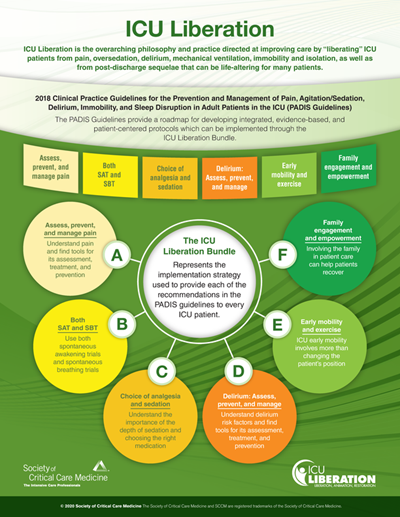The Society of Critical Care Medicine's (SCCM) ICU Liberation Bundle (A-F) is a collection of resources and guidance to implement key elements of the of the 2018 pain, agitation/sedation, delirium, immobility, and sleep disruption (PADIS) guidelines to every ICU patient.
The ICU Liberation Bundle has been proven in multiple studies involving more than 20,000 patients to:

Decrease the likelihood of hospital death within seven days by 68%

Reduce delirium and coma days by 25% to 50%

Cut ICU readmissions in half
The ICU Liberation Bundle consists of the following individual elements
Access assessment tools, interventions, and resources for each element of the Bundle. Pediatric considerations and resources are also included in each element.
Click each tab to learn more about that element.
The ICU Liberation Implementation Toolkit provides adult and pediatric critical care teams with a variety of resources to champion and sustain bundle implementation. The toolkit contains:
Use of SCCM's ICU Liberation material is approved for free staff training in hospitals and, in most circumstances, for use in scientific presentations. If the use falls into this category, please ensure that appropriate acknowledgment is given to ICU Liberation. Some content on the website may require permissions from other creators that preceded the SCCM ICU Liberation program.
For medical education programs with associated registration fees or for use in commercial settings, requests for use of SCCM materials should be made in advance by contacting iculiberation@sccm.org.
The Society does not endorse any specific product, platform, or other information that may be mentioned.
